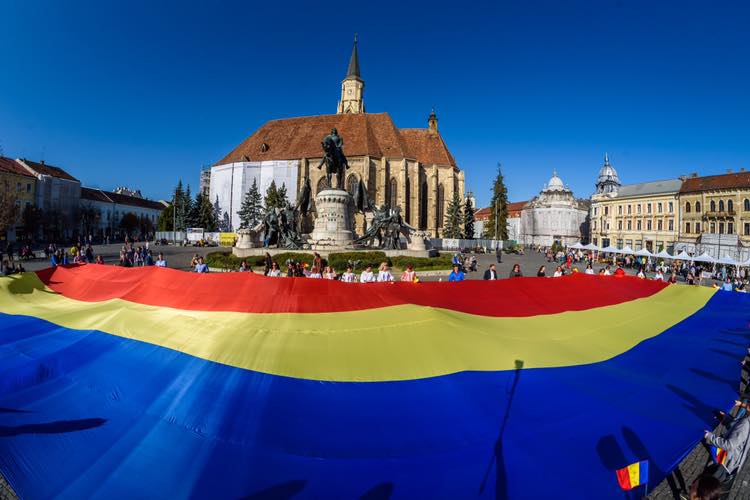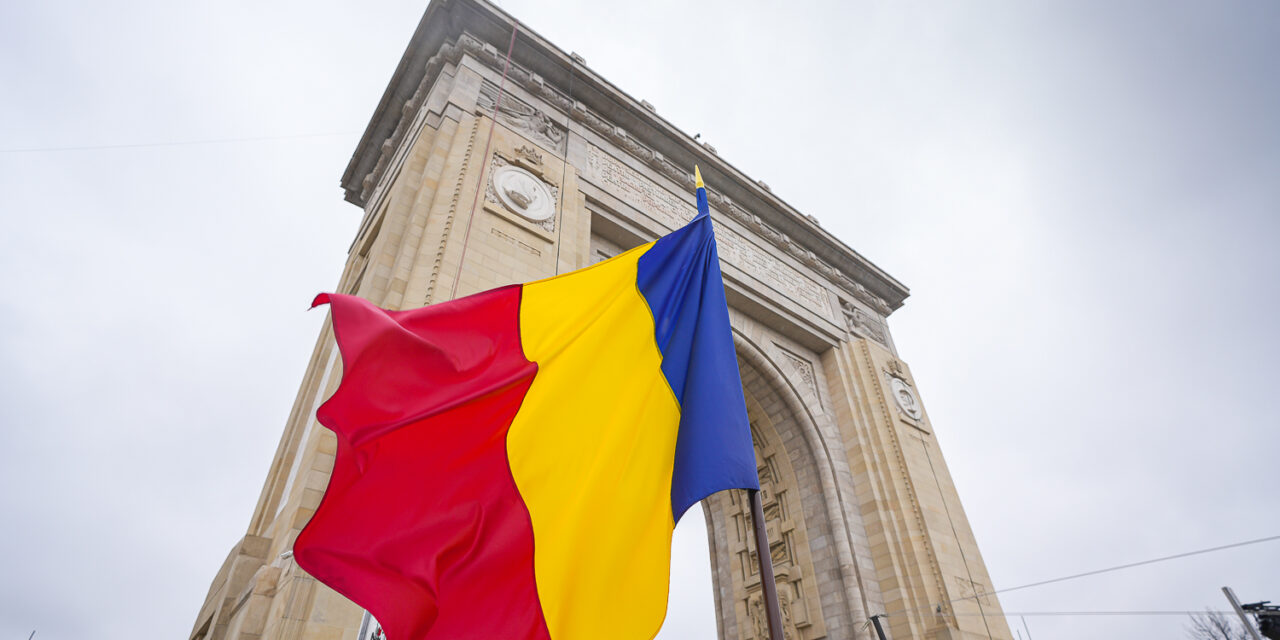Romanian history is replaced by a kind of peculiar national mythology. Written by Attila Zsolt Borbély.
This year, the Romanian national holiday, the commemoration of the Romanian National Assembly on the first of December in Székelyföld, did not take place without provocation either. Mihai Tirnoveanu, whose name became known to the Hungarian public in connection with the series of crimes committed in the Úzvölgy military cemetery, and who inscribed himself in the hearts of the local population in Kézdivásárhely last year, visited Sepsiszentgyörgy this year after the official ceremony with members of the organization Calea Neamului and with his supporters, and gave an inciting speech full of falsification of history and other kinds of untruths.
Tirnoveanu, just like the extreme Hungarian-hating political group called AUR, is a symptomatic phenomenon, which is the product of the indoctrination of the Romanian national ideology, which looks back on a century and a half and views Hungarians as the archenemy.
It would be nice to believe that communism failed in Central and Eastern Europe not because the leadership of the great powers and those behind them saw it as useful, tactical, and in line with their interests, but because a long-term viable power system cannot be built on lies. because the truth always makes its way.
But whether we believe all this or not, it is a matter of fact that for a person blessed with a sound moral sense, the most intolerable was the falsehood running through the entire system, the fact that we knew that the official dogmas were based on lies, whether it was a view of history, economics or party ideology, we knew that the state leaders also know that they lie, and they also knew that we knew it.
In the Ceausescu regime, Transylvanian Hungarians were not only forced to endure the lies of the system, but also the already mentioned Romanian national ideology built against it, false in all its elements.
Romanian history is replaced by a kind of peculiar national mythology.
This is based on the Dáco-Romanian theory, which is professionally untenable and cannot be taken seriously, and which is even refuted by some brave Romanian historians (most recently Dan Alexe published this year in his work Let's play dákosdit and rómaiasdit!), but their voice does not reach even one percent of the population. Such anachronisms are given a prominent role in this collection of myths, such as Vojda Mihály's intention of national integration, guided by which he "united" the "Romanian countries" in 1600, including Transylvania.
Part of the mythology is also that the "great unification", in other words, the acquisition of Transylvania in a broad sense, took place on December 1, 1918.
Romanian political communication, national propaganda and education have always tied their grip on Transylvania to the Gyulafehérvár resolutions adopted 105 years ago. Since then, four or five generations have grown up, whose members were taught that the fate of Transylvania was decided then, even though nothing was decided at that time. The end result required the masonic ambition, the will of great powers and the catastrophic policy associated with the name of Mihály Károlyi, the disarmament of the Hungarian army when it was most needed, when the Hungarian soldier could have fought for his own country instead of foreign interests.
And then we didn't mention that on December 22, 1918, a people's assembly of at least that size stood up in Cluj-Napoca in favor of Transylvania belonging to Hungary.
It is worth quoting a few lines from the speech of István Apáthy, the President of the Hungarian National Council and then High Commissioner for Eastern Hungary:
"we were not defeated so much that any nation living around us would have the right to rule over us. They did not win so much that all the nations living here have the right to declare the country to be divided and to annex one piece to one country and another piece to the other country. [...] In Gyulafehérvár, the Romanian national committee declared that the Romanians of the 26 counties of Hungary are united with Romania and thus all the population living in the territory of the 26 counties belong to Romania. Only two million, nine hundred and eighty thousand, one hundred and eighty-six Romanians live in this area, compared to almost four million non-Romanians. These do not have the right to decide over the majority that opposes them."
This People's Assembly also adopted a resolution according to which those gathered demand "complete equality, freedom and self-government" for the nations in Transylvania "within the framework of a united and unmutilated Hungary".
When at the end of July 1990, the Romanian parliament declared the first of December a national holiday, it put a stop to a date that is a day of mourning for more than one and a half million citizens of the country. Indeed, there would have been an alternative, for example, December 22, if not for the mentioned Cluj People's Assembly.
The Ceausescu dictatorship fell on this day in 1989. The cathartic joy of this day will never be forgotten by those who experienced it.
But December 16 could have been a national holiday, the anniversary of the popular uprising in Temesvár, the anti-communist opposition also had a proposal in this direction. December 16th would have commemorated the Romanian-Hungarian reunion and joint success. On this day, the protesting, mixed-ethnicity crowd that gathered around the parish of László Tőkés, demanding regime change, and then occupying the Communist Party building, could not be restrained by the armed forces.

Photo: TNL Cluj Facebook
But it was more important for the Romanian post-communist parliamentary majority to triumph. Since then, the national holiday has been the source of many anti-Hungarian provocations, starting from the fact that since 2014 it is mandatory to name a street in every city under Romanian authority from the first of December, up to the celebration of the day of mourning in Székelyföld. The height of these provocations was when the then Romanian Prime Minister Adrian Nastase celebrated in Budapest in 2002 at the Kempinski Hotel, toasting his Hungarian colleague Péter Medgyessy with champagne in the presence of the then RMDSZ faction leaders.
Since the regime change, no one has ever managed to stomp on our national self-esteem so much. socialist worldview and total insensitivity to the category of national dignity. Hungarian honor was saved by protesters in front of the hotel.
Since 1990, the Hungarian representation in Transylvania has focused on the promises contained in the Gyulafehérvár resolutions, which included the autonomy granted to non-Romanian national communities.
When, on the occasion of the centenary five years ago, Kelemen Hunor, the president of the RMDSZ, dared to say that
"Romania [...] must accept that we will not be able to celebrate 1918 and do not even want to", it became a scandal.
However, it was a clear and straightforward speech that was easy to follow. It's a pity that the database 1000 years in Transylvania, 100 years in Romania compiled by RMDSZ and mentioned in the interview just quoted was compiled in the name of self-censorship, cultural mutilation, let's say, "cancel culture" according to the taste of the leftist mainstream.
Looking at the roster of the literary portrait hall, we can see that Pál Bodor and Géza Domokos were included, but Dezső Szabó was not. And not only Dezső Szabó, who wrote the greater part of his life in Budapest, but also Albert Wass, József Nyirő and Sándor Reményik. The first two have been in the crosshairs of the left for a long time, their omission may be simple political cowardice, which unfortunately has always characterized the Labanc wing of the RMDSZ, which has dominated since 2003. But for the omission of perhaps the greatest poet of the post-Trianon era, Sándor Reményik, we can no longer find any other explanation than ideological censorship.
Returning to Kelemen Hunor's interview, it is worth quoting another part of it.
"Romania cannot show great achievements in the year of the centenary. […] They won't be able to say that we built 1,800 km of highway, that we finally connected the historical regions after a hundred years. They cannot report that today, if you get on the train in Bucharest, you will reach Balázsfalva sooner than a hundred years ago. They will be able to tell you that today it takes one and a half hours more to travel from Balázsfalva to Bucharest than a hundred years ago."
Unfortunately, this is the reality.
In 1920, the then-Romania received and brought under its control a much more developed, turnkey country, which it was unable to build further, which it has treated as a colony for more than a hundred years. And now those whose ancestors built this country and kept it in the midst of the storms of history for a thousand years are being humiliated year after year.
Featured Image: Klaus Iohannis Facebook













